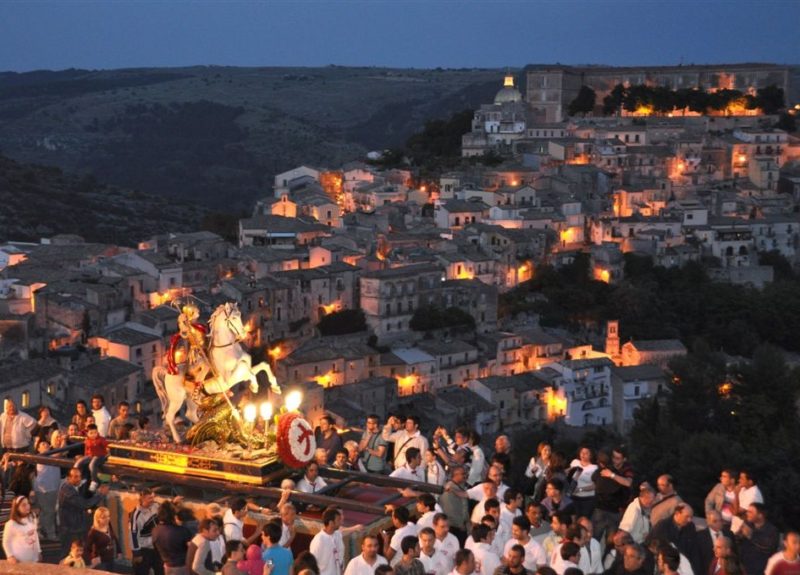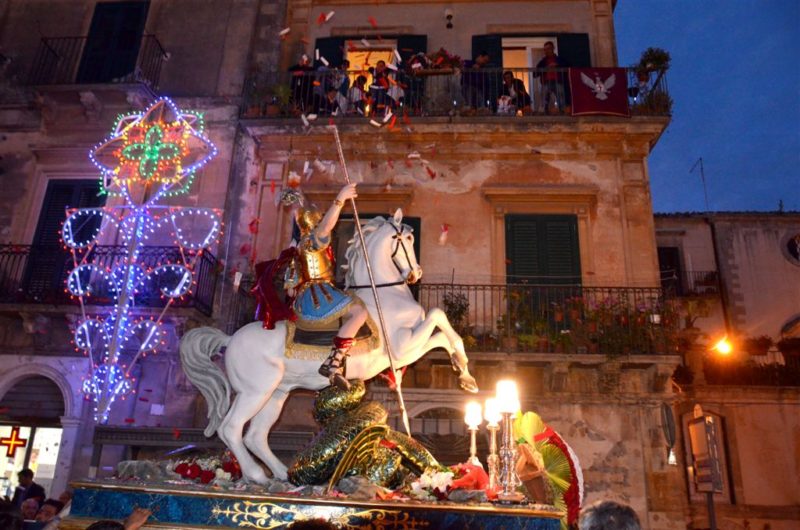Patronal feast of San Giorgio martyr - Ibla
Street View (if present)
Description
Patronal feast of St. George the martyr


----------------
Technical sheet prepared by: Region of Sicily - Department of cultural heritage and Sicilian identity - CRicd: Regional center for inventory, cataloging and documentation and Sicilian regional film library
Intangible Heritage Register
N. Prog. 196
Well: patronal feast of San Giorgio martyr
Book: REIS - Book of Celebrations, Holidays and Ritual Practices
Approval date: 18-02-2015
Category: Patronal feast
Province: Ragusa
Location: Ragusa Ibla
Municipality: Ragusa
Local denomination: Scinnuta and Abballariata
Chronological News
St. George (Cappadocia, about 275-285 - Nicomedia, April 23, 303) is the holy Christian martyr revered by almost all the Christian Churches that admit the cult. Its history has come down to us from an ancient text called "Passio Georgi", Considered an apocryphal work according to"Gelasian Decretumum ”of 496 AD by Pope Gelasius I. In the family both parents educate him to the Christian religion until the year in which George embarks on a military career as an officer in the militias. He moves to Palestine, where he is drafted into the army of Emperor Diocletian. George renounced the pagan religion (polytheist) to defend the Christian cult and because of this he was martyred after suffering bloody punishments.
In Sicily many municipalities are linked to the cult of the holy martyr of the Church: we remember Agrigento, Barcellona Pozzo di Gotto, Caccamo, Modica, Calatabiano, Messina, Monreale, Enna, Palermo and Ragusa Ibla.
There are several representations of the figure of St. George: standing, sitting on a throne, half-length or on horseback in the act of piercing the dragon, often also surrounded by images depicting life and martyrdom. The most common representation in Ragusa is that of the knight holding a spear or sword, with the shield depicting the curved cross, in the act of piercing the dragon.
The story of the feast of St. George has very ancient origins in the city of Ragusa, being already patron of the town before 1693, the year of the earthquake that shocked the whole of eastern Sicily, when the city of Ragusa was composed only of the baroque quarter of Ibla . After 1693, with the creation of the new town of Ragusa Superiore, the cult of San Giovanni Battista spread, a solemn feast of the people, celebrated in Ragusa in the novenary from 20 to 29 August. Since that time Ragusa has been divided betweenSangiorgiaries (supporters of the priority of the cult of San Giorgio di Ibla) e Sangiovannari (supporters of the priority of the new cult of San Giovanni di Ragusa). If on the one hand the feast of St. John is more intimate and more religious, the feast of the knight George is certainly richer in popular tradition and folklore, it is the feast of fireworks, the saint's ballad, musical performances and even the so-called "martyrdom".
Recurrence: Annual
Date: Last Sunday in May (although the calendar would take place on April 23)
Occasion: Feast of the Patron Saint of Ragusa Ibla
Function: Devotional / Patronal
Actors: Civil authorities (the Mayor) and religious authorities (Bishop of the Diocese of Ragusa), bearers of the launch, brotherhoods of the town, figures of the historical parade.
Participants: Devotees, local community, tourists
Description
The historical information on the feast of S. Giorgio in Ibla dates back to the sixteenth century. The celebratory event is characterized by a long series of celebrations dedicated to the Saint that take place in an atmosphere of joy and triumph expressed in the traditional dazzled. The procession is opened by the banners of the various Iblean brotherhoods, each present with traditional costume, accompanied by lights, music and sounds, fireworks and shows. On the Roman calendar, the feast of the saint falls on April 23, but the celebrations always take place on the last Sunday of May or even at the beginning of June (as in the last two years).
The rite is divided into several actions aimed at celebrating the Saint: on the Sunday before April 23, the spectacular translation or skinny the simulacrum of San Giorgio and the Holy Ark inside the Ragusa cathedral; during the triduum at the end of May the following are held: the Historical parade, which recalls the battle of the saint against the Dragon with a large allegorical chariot in which the protagonists of the story appear; the Friday procession, when St. George and the Holy Ark leave the Cathedral to reach the Church of Purgatory, located in the Piazza Repubblica area, located at the entrance to Ibla, where the holy ark remains while the simulacrum of St. George it is instead placed inside the church of S. Tommaso, near the Hyblaean gardens; the Saturday procession, which starts from S. Tommaso with the simulacrum and continues up to Purgatory where the holy ark is taken, so as to be able to return together with the Cathedral; on Sundays, the whole city lives around its patron saint and after the Holy Mass in the afternoon the expectation for the "exit" grows, preceded by the municipal bands and flag-wavers who introduce thedazzledand the main procession, solemn, accompanied by the brotherhoods with the various banners and banners of the Municipality and Province. At the Iblei Gardens the bearers of the vara load the Patron on their shoulders leaving the chariot, and carrying him in their arms, they continue towards Piazza Duomo they will make him dance as tradition, even hoisting him high with outstretched arms, screaming continuously All Truonu! which means that he is the patron saint of the city. The pyrotechnic games close the celebrations.
Characterized by the procession that unfolds through the streets of Ibla, the statue of the knight (represented on horseback, dressed as an ancient soldier, armed with a silver lance while facing and killing a terrible dragon) is carried on the shoulders by the faithful and followed. by a crowd of devotees.
REFERENCES
Cirnigliaro, Nino, edited by. 2003. St. George the Martyr. The cult and tradition in Ragusa and in the world. Ragusa, Ragusa Cathedral.
Footnotes
The statue of St. George is the work of the Palermo sculptor Rosario Bagnasco of the second half of the nineteenth century. The statue of the knight is preceded by another sedan chair on which is placed the "holy chest" in silver worked with the relics of the saints.
Card Author: Chiara Dell'Utri
Go to Google Maps
Send a notice to the publisher
[contact-form-7 id="18385"]





